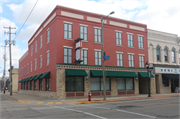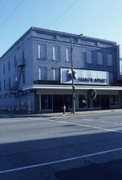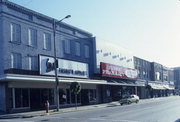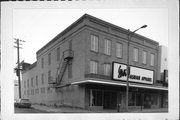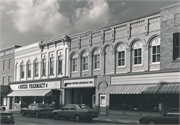Property Record
200 E MAIN ST
Architecture and History Inventory
| Historic Name: | Maldaner-Peterson Building; The Dutch Store |
|---|---|
| Other Name: | Elliott's Fashion Apparel |
| Contributing: | Yes |
| Reference Number: | 75458 |
| Location (Address): | 200 E MAIN ST |
|---|---|
| County: | Jefferson |
| City: | Watertown |
| Township/Village: | |
| Unincorporated Community: | |
| Town: | |
| Range: | |
| Direction: | |
| Section: | |
| Quarter Section: | |
| Quarter/Quarter Section: |
| Year Built: | 1851 |
|---|---|
| Additions: | 1853 1856 |
| Survey Date: | 19862020 |
| Historic Use: | large retail building |
| Architectural Style: | Commercial Vernacular |
| Structural System: | |
| Wall Material: | Brick |
| Architect: | |
| Other Buildings On Site: | |
| Demolished?: | No |
| Demolished Date: |
| National/State Register Listing Name: | Main Street Commercial Historic District |
|---|---|
| National Register Listing Date: | 6/2/1989 |
| National Register Multiple Property Name: |
| Additional Information: | This building was constructed for Henry Muldaner's store, also known as the Dutch Store, a derivative of "Deutsch" reflecting his German heritage. Maldaner came to Watertown in 1848. He operated a general store with Andrew Peterson until 1854, then in 1856-57 operated a store with William Volkman, after which he left the retail business to give full attention to other business interests. Between 1880 and around 1925 the building housed the Beurhaus general store, operated by William Beurhaus. Later, Henry Beurhaus operated a shirt factory on the upper floors of this building. In 1927 the building began to house the Elliott's dress shop, a business still there today. This building is significant for local history under National Register criterion A because it was the location of the pioneer store operated by Henry Maldaner. Later, it was the long-time location of the William Beurhaus general store. There were several general stores that managed to survive beyond the pioneer era. One such store was Maldaner's store. In fact, along with Jacob Weber and Luther Cole, Maldaner's store was one of the most successful of the pioneer general stores. While this building meets the individual eligibility criteria for local history it also contributes to the overall development of commerce in the Main Street Commercial historic district because it was a commercial building throughout the historic period. Constructed of cream brick in the early 1850's, the Maldaner and Peterson building historically known as the Ducth Store is a simple vernacular seven-bay brick block with a double storefront. Exhibiting a molded brick cornice decorated by a row of dentils and a paneled freize, the Dutch Store has rectangular windows with stone flat straight lintels and stone sills. An exterior metal stairway is located on the west elevation. A two story 1856 brick rear addition features a corbelled rbick cornice, segmental arched windows. The Dutch Store has been altered by the application of paint to the brick exterior, by the filling in of the windows on the west elevation and at the rear and by the addition of the contemporary storefronts and canopy. The Maldaner and Peterson building historically known as the "Dutch Store" is significant under criterion C as an example of commercial vernacular architecture. Among the best preserved of the simple commercial vernacular brick buildings from the early 1850's period of development, the "Dutch Store" exhibits a simple brick cornice decorated with classical dentils and a paneled freize. Other good examples of the rather utilitrian early vernacular brick commercial buliding ornamented only by a raised brick cornice is the J.W. Cole buliding built a few years later at 201-205 E. Main (65-9) and the 1871 Duffy uilding at 217 E. Main (65-10). A similar but less significant example of the commercial vernacular form is the building at 223 W. Main (68-24). Built in 1851, this building originally owned by Henry Muldaner and Andrew Peterson received an addition with a second storefront on the east side in 1853. However, it was designed to appear as one large brick block in a manner commonly seen in the proposed Main Street Historic District. |
|---|---|
| Bibliographic References: | (A) Tax Records, City of Watertown, 1860-1910, Area Research Center, University of Wisconsin-Whitewater. (B) Watertown Chronicle April 23, 1851; May 12, 1851; July 28, 1851; Aug. 31, 1853. (C) Photograph, Folio, City of Watertown, 1887, Archives, Octagon House, Watertown Historical Society. (D) Watertown Democrat June 5, 1856. (E) Watertown City Directories, 1866-1930, Watertown Public Library. (F) C.W. Butterfield, The History of Jefferson County, Wisconsin, Chicago: Western Historical Association, 1879, p. 617. |
| Wisconsin Architecture and History Inventory, State Historic Preservation Office, Wisconsin Historical Society, Madison, Wisconsin |

